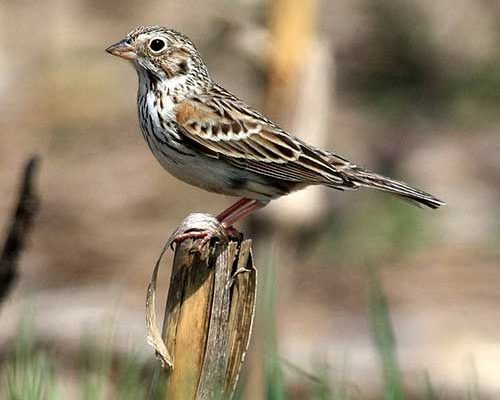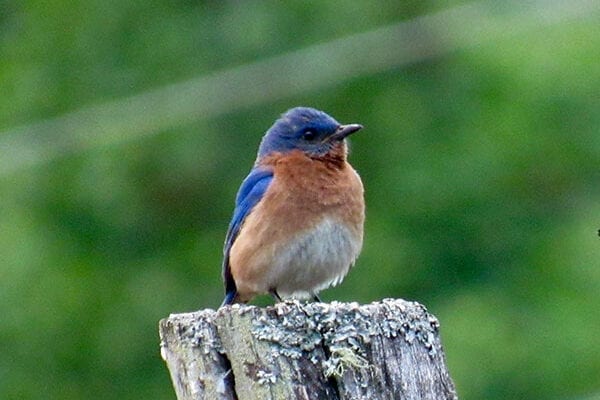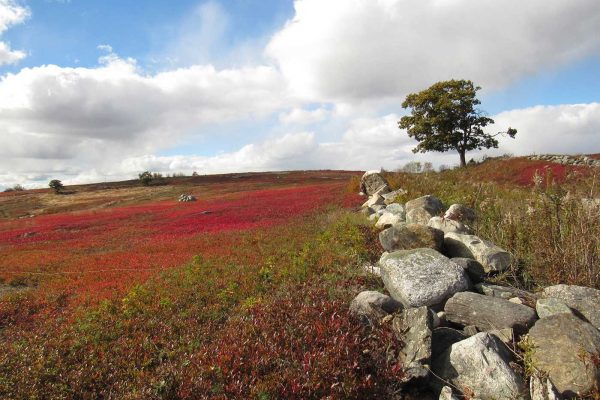Some places are special for all sorts of reasons. Take Clarry Hill in Union. Its high elevation provides spectacular views of the Camden Hills, glimpses of Muscongus Bay, and acres upon acres of lowbush blueberries that are highly valuable to local jobs and Maine’s economy.
These lands are also important for countless species of birds. Clarry Hill is, to quote the Midcoast Conservancy, “a vital place, where wildlife, agriculture, recreation, and Maine’s natural splendor all converge.”

Clarry Hill provides vital habitat for many declining bird species, such as the Vesper Sparrow. Credit is Photo by “Tim of Ithaca courtesy of Wikimedia Commons”
Now, imagine a subdivision of cookie-cutter houses, or another McMansion, spoiling this picturesque place.
For us and other birders, such a thought seems incomprehensible. Found here are Vesper Sparrows—so named for their propensity to sing vigorously in the evenings (“vesper” means “evening” in Latin). Like many grassland specialists, it has suffered significant population declines due to habitat loss. Savannah Sparrows share their buzzy tsee-tsay songs here as well; once seemingly ubiquitous across hayfields and other open habitats across the state, this species is getting harder and harder to find these days.
The forest edges of Clarry Hill also offer a delight to the senses. In the breeding season, there are flashes of greens, reds, blues—just about every color in the form of Scarlet Tanagers, Eastern Bluebirds, and other songbirds. The place echoes with the trills of Pine Warblers, the accelerating whistles of Field Sparrows, the melancholy slur of Eastern Wood-pewees. Eastern Towhees insist you “SIP-your-TEEA.” One winter, birders from across the Midcoast region trekked here to see the splendor of a visiting Snowy Owl. The late Peter Vickery, a legend among Maine birders and author of the newly published definitive tome Birds of Maine, once found a rare Buff-breasted Sandpiper here.

Eastern Bluebirds can be heard singing from the wooded areas of Clarry Hill. Photo by Kristen Lindquist
Hawk-watching enthusiasts may spend an entire day at Clarry Hill, watching as these magnificent birds of prey pass overhead in mind-boggling numbers. New York Times best-selling author of A World on the Wing Scott Weidensaul commented, “Witnessing the 14,000 migrating hawks, eagles, and falcons from the summit of Clarry Hill is exhilarating. It’s one of only three hawkwatch sites in the state that is regularly and fully staffed, and its data contribute to the Hawk Migration Association of North America’s continental raptor population index. It is critical that we protect this special place.”
So it was with shock and horror that we heard that two large parcels (one that is 212 acres and another, 51) had been placed on the real estate market in late 2022.
Fortunately, with that news included a note that actions were already underway to secure these lands, thanks to the quick response and negotiating skills of the Midcoast Conservancy.
How extraordinary is Clarry Hill? We had been lulled into telling ourselves it was already protected. In fact, large portions of it have been, thanks to the Land for Maine’s Future program, which is strongly supported by the Natural Resources Council of Maine.
Thankfully, alarm bells sounded in time for Clarry Hill, notifying us of an opportunity to grow the number of conserved acres at this amazing place.

In fall, after the harvest season, blueberries barrens become a photographer’s dream as they turn brilliant red. (Clarry Hill blueberry barrens, Union, by Kristen Lindquist)
Such an effort is all the more important as blueberry barrens are becoming increasingly scarce on the Maine landscape. Historically, they were already confined to the relatively few places where conditions are just right, formed by melting glaciers many thousands of years ago. In modern times, land management (often including carefully controlled fires and mowing) has kept the fields from growing up into forests. In recent decades, housing developments, changes in the blueberry industry, and other factors have led to the loss of more and more blueberry barren land.
Of course, it’s natural to think of the berries themselves when you hear the word “blueberry barren.” Why wouldn’t you? It’s the Maine State Berry and a signature agricultural crop of our state. In late July through early September (depending on location), blueberry barrens turn blue with these sweet, delicious little orbs. But blueberry barrens are just as colorful—certainly more noticeably so, at least from a distance—during the fall, when the leaves turn a brilliant red.
Blueberry barrens are magnificent places in any season, and Clarry Hill is exemplary among them. If you have yet to visit, we hope you will soon. And we encourage you to learn more about the Clarry Hill Highlands project, too. We think you will agree, it is a rare opportunity to make a difference.
—Jeff and Allison Wells
Banner photo: Pine Warbler by Pam Wells









Leave a Reply